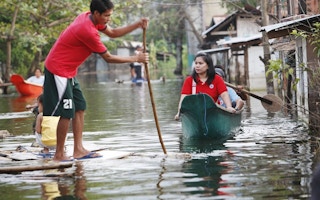When heavy rains hit the tiny West African nation of Togo in September, filling a hydropower dam close to overflowing, the Togolese Red Cross took an unusual step.
Rather than simply putting aid supplies in place to prepare for flooding, the agency sent cash to families living downstream so they could move out of the expected flood path. It also provided simple protection, such as plastic bags in which to keep birth certificates and other key papers dry.
“If an event hits and you’re not prepared, only then is it going to become a disaster,” said Pablo Suarez of the Red Cross Red Crescent Climate Centre, which is working increasingly on innovative ways to get money to threatened communities before disasters strike, to hold down costs and losses.
As the world figures out ways to deal with worsening extreme weather and slower climate change effects such as sea-level rise and desertification, while speeding up adoption of clean energy, creativity will be needed to make the limited funds available stretch further and prevent losses from spiralling out of control, experts said at this week’s UN climate talks in Marrakesh.
“
Vulnerable communities are suffering growing losses each year…from smaller, more frequent “everyday disasters” that are gradually soaking up more of their income.
“It’s a no-brainer that the more we do on mitigation (of climate-changing emissions), the less we need to do on adaptation, and the less we have to spend on humanitarian work,” said Harjeet Singh, global lead on climate change for the charity ActionAid.
But for the poorest and most vulnerable communities, focusing first on reducing emissions by adopting clean technology - something richer countries see as the clear priority - isn’t obvious or easy, said India-based Singh.
Growing losses
That is largely because vulnerable communities are suffering growing losses each year, not just from major storms and droughts but from smaller, more frequent “everyday disasters” that are gradually soaking up more of their income.
Colin McQuistan, of development charity Practical Action, pointed to Bangladeshi families that need to spend a larger share of their income on sandbags each year to protect their homes from river erosion.
“Communities are reporting that more and more of their resources have to be allocated for these types of measures. What that means is they have less to invest in their development,” he said.
As a result, when climate-affected communities are approached to install solar panels, for example, they are often enthusiastic but have no spare cash to invest.
“It’s not either/or” when it comes to curbing emissions and coping with climate stresses, Singh said. “It’s just that people say, ‘I have to protect my home, my income, my family - and at the same time look at long-term solutions’.”
Developed nations have things in the wrong order when they want the poor to work first on cutting emissions, he said, because their priority is to find relief for climate-linked disasters.
“Then people start talking about how this is the new normal and we need to do something, and they invest in risk reduction and adaptation. And only then do they look at the larger question of mitigation (of emissions),” he said.
That could be changed partly by making sufficient international cash available to help the most vulnerable nations adapt to climate change, experts say.
The latest UN figures released in Marrakesh on Monday show that no more than one dollar in every four of global climate finance goes to adaptation.
“If we really want to see ambition, particularly from developing countries and particularly in the next few years, climate finance is the key that can unleash the potential,” Singh said.
Intellectual property
Other innovative ideas could help. Singh suggested, for instance, that funding through the US$10-billion Green Climate Fund could be used to buy out the intellectual property rights of ground-breaking clean energy technology to make it available far more cheaply for countries such as India.
That kind of investment could both meet the fund’s mission to shift paradigms, and help clear the way for rapid scaling-up of clean technology in developing countries - a key to keeping global warming to well under 2 degrees Celsius, as agreed in Paris last year, Singh said.
“If you create the conditions to attract trillions of dollars in investment, you can enable transformation in no time,” he said.
That is particularly crucial now, said Liz Gallagher, a climate diplomacy expert at London-based environmental think tank E3G. “The next 15 years are going to fundamentally change our climate in a good or bad way” as long-term energy investments are made, she said.
This story is published with permission from the Thomson Reuters Foundation, the charitable arm of Thomson Reuters, that covers humanitarian news, women’s rights, trafficking, property rights and climate change. Visit http://news.trust.org










